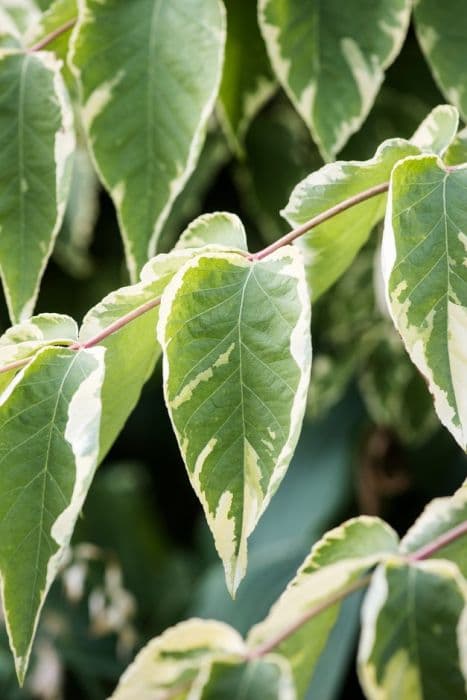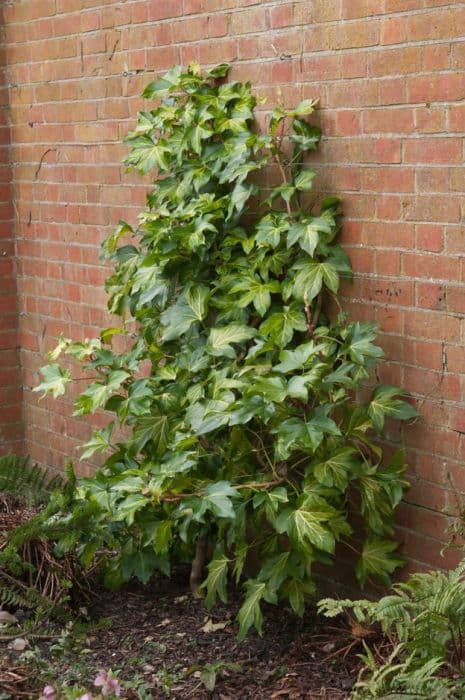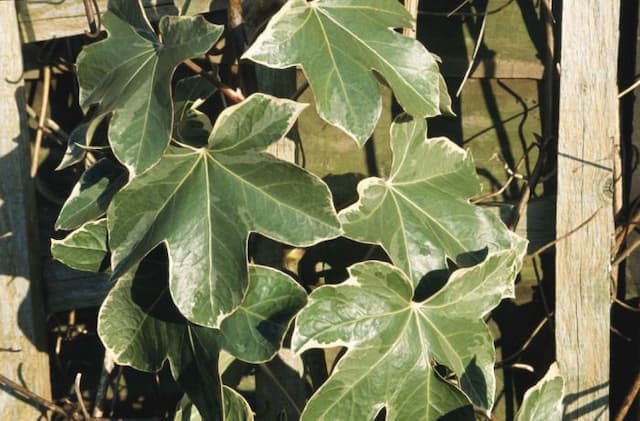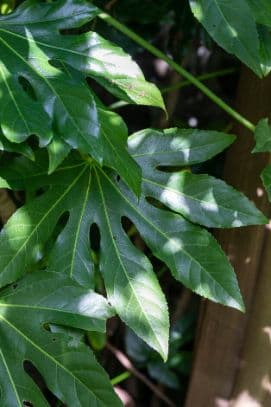Persian Ivy Hedera colchica 'Sulphur Heart' (v)

ABOUT
Persian ivy 'Sulphur Heart', also known as variegated Persian ivy, is a striking climber known for its ornamental foliage. The large, heart-shaped leaves are glossy and have a bold, irregular splash of yellow or golden variegation in the center, typically against a deep green background. Younger leaves may exhibit a brighter chartreuse coloration, gradually maturing to a deeper hue. The variegation patterns on the leaves can be quite variable, with some showing more green and others more of the yellow or creamy color. The leaves are leathery to the touch, demonstrating durability. This plant can produce small, roundish flowers, which are not particularly showy compared to its foliage, and it may bear bluish-black berries. As a climbing or trailing plant, Persian ivy 'Sulphur Heart' is often used to cover walls, trellises, or as ground cover, where it displays a cascading effect of its vibrant foliage.
About this plant
 Names
NamesFamily
Araliaceae.
Synonyms
Persian Ivy, Colchis Ivy, Sulphur Heart Ivy.
Common names
Hedera colchica 'Sulphur Heart'.
 Toxicity
ToxicityTo humans
Persian ivy is considered to be toxic if ingested. It contains compounds such as saponins and polyacetylene compounds that can cause irritation and burning in the mouth and throat, excessive drooling, difficulty in swallowing, and stomach upset leading to vomiting and diarrhea. In severe cases, contact with the sap can also cause skin irritation or dermatitis. It is important to handle the plant with care and ensure that children do not chew on the leaves or stems.
To pets
Persian ivy is toxic to pets if ingested. The plant contains saponins and other irritant compounds that can cause similar symptoms as in humans. These include oral irritation, excessive drooling, vomiting, diarrhea, and abdominal pain. In severe cases, ingestion can lead to more serious conditions like dehydration, difficulty in breathing, or even coma. It is crucial to prevent pets from chewing or ingesting any part of this plant.
 Characteristics
CharacteristicsLife cycle
Perennials
Foliage type
Evergreen
Color of leaves
Variegated
Height
10 feet (3 meters)
Spread
10 feet (3 meters)
Plant type
Climber
Hardiness zones
7
Native area
Caucasus
Benefits
 General Benefits
General Benefits- Ornamental Appeal: Adds aesthetic value to gardens with its variegated heart-shaped leaves.
- Easy Maintenance: Requires minimal care once established, making it suitable for busy gardeners.
- Versatility: Can be used in a variety of garden settings, including walls, trellises, and as ground cover.
- Drought Tolerance: Survives in dry soil conditions once established, reducing the need for frequent watering.
- Shade Tolerance: Thrives in shaded areas where other plants may struggle to grow.
- Seasonal Interest: Provides evergreen coverage throughout all seasons, maintaining garden interest year-round.
- Wildlife Support: Offers shelter and sometimes food for birds and insects within the garden ecosystem.
- Fast Growth: Covers large areas quickly due to its vigorous growth habit, ideal for creating privacy screens.
 Medical Properties
Medical PropertiesThis plant is not used for medical purposes.
 Air-purifying Qualities
Air-purifying QualitiesThis plant is not specifically known for air purifying qualities.
 Other Uses
Other Uses- Hedera colchica 'Sulphur Heart', commonly known as Persian ivy, can be used to create living sculptures by training the vines over wire frames to shape them into forms such as animals or geometric designs.
- In the fashion industry, the unique variegated leaves of Persian ivy are sometimes replicated in fabric prints or patterns for clothing and accessories.
- Persian ivy can be employed in landscape design to create natural fences or living walls for privacy screening in gardens and urban spaces.
- This plant's dense foliage offers a natural habitat for beneficial insects, providing a haven for ladybirds and other predatory insects that help control garden pests.
- Creative crafters may use the vines and leaves for making decorative wreaths and other botanical art pieces.
- Due to its dense matting habit, Persian ivy can be used to stabilize soil on hillsides and prevent erosion in areas prone to losing topsoil due to rain or wind.
- The leaves of Persian ivy can be used as a natural dye, providing a range of green hues for textiles, depending on the mordant used.
- In sound-sensitive areas, the dense foliage of Persian ivy can contribute to noise reduction by acting as an organic sound barrier on fences or walls.
- Persian ivy is occasionally practiced in topiary arts, where the vines are guided over topiary frames to create intricate and formal garden features.
- Persian ivy can also serve as a backdrop for photography, offering a lush, evergreen setting for professional or casual photoshoots.
Interesting Facts
 Feng Shui
Feng ShuiThe Persian Ivy is not used in Feng Shui practice.
 Zodiac Sign Compitability
Zodiac Sign CompitabilityThe Persian Ivy is not used in astrology practice.
 Plant Symbolism
Plant Symbolism- Everlasting Bonds: The plant commonly known as Persian Ivy epitomizes long-lasting connection and fidelity due to its clinging growth habit, which symbolizes a clinging nature in relationships.
- Protection: Persian Ivy is often connected with safeguarding, as it creates an enveloping canopy over structures or trees it climbs, presenting a protective shield.
- Eternal Life: The evergreen nature of Persian Ivy, which remains green throughout the year, represents immortality and the continuous cycle of life.
- Friendship: The plant's ability to interweave and support itself on surrounding structures is seen as a metaphor for the interconnectivity and support provided by friends.
- Growth and Vitality: Persian Ivy's vigorous growth habits symbolize robust health and relentless growth, both physically and in personal development.
 Water
WaterPersian Ivy prefers consistently moist but well-drained soil. Water the plant thoroughly when the top inch of soil feels dry to the touch, which typically translates to once a week. For indoor potted plants, you might need 16 to 24 ounces of water for each watering session, depending on the size of the pot and the environmental conditions. During the active growing season in spring and summer, the Persian Ivy may require more frequent watering than in the fall and winter when growth slows. Always adjust water frequency based on temperature, light levels, and the plant's overall health.
 Light
LightPersian Ivy thrives best in bright, indirect light but can also adapt to partial shade. It should not be exposed to direct sunlight as it can scorch the leaves. An ideal spot for this plant would be in a room with large windows that receive filtered light throughout the day or near a north-facing window.
 Temperature
TemperaturePersian Ivy is quite hardy and can tolerate a temperature range from 50°F to 80°F, though the ideal temperature for this plant is between 60°F to 70°F. It can survive short periods outside this range, but prolonged exposure to temperatures below 50°F or above 80°F can damage the plant.
 Pruning
PruningPruning Persian Ivy helps maintain its shape, encourage bushier growth, and remove any unhealthy or dead foliage. It's best to prune in the early spring before new growth begins. Pruning can be done as often as needed to keep the plant looking tidy, but avoid heavy pruning more than once a year.
 Cleaning
CleaningAs needed
 Soil
SoilPersian Ivy 'Sulphur Heart' prefers well-draining soil rich in organic matter with a pH range of 5.5 to 7.5. A good soil mixture for this plant can be made with equal parts of garden loam, peat moss, and perlite to ensure adequate drainage and aeration.
 Repotting
RepottingPersian Ivy 'Sulphur Heart' should be repotted every two to three years to refresh the soil and accommodate root growth. Spring is the ideal time for repotting to allow the plant to recover during its active growing season.
 Humidity & Misting
Humidity & MistingPersian Ivy 'Sulphur Heart' thrives in moderate to high humidity levels, ideally between 40-60%. If indoor air is dry, misting the plant regularly or using a humidifier can be beneficial.
 Suitable locations
Suitable locationsIndoor
Place in bright, indirect light and maintain moderate humidity.
Outdoor
Plant in partial shade, shelter from harsh sun, and protect from extreme cold.
Hardiness zone
6-9 USDA
 Life cycle
Life cycleThe Persian Ivy 'Sulphur Heart' (Hedera colchica 'Sulphur Heart') begins its life cycle when seeds are dispersed by birds or germinated from cuttings, initiating the growth of juvenile leaves, which are heart-shaped with a variegated yellow and green pattern. This climbing or ground-covering evergreen plant then enters a stage of rapid vegetative growth, using aerial rootlets to adhere to surfaces, or spreading across the ground. As it matures, Persian Ivy develops adult foliage that is larger and more unlobed, eventually producing small, inconspicuous greenish-yellow flowers in the late summer or early autumn. Pollination occurs mainly by insects, leading to the production of small, black-purple berries that are typically ingested and dispersed by birds. These berries contain the seeds for the next generation, completing the reproductive cycle. The plant can live for many years, achieving its mature form with a robust woody stem structure and expansive foliage cover, and can continue to expand its growth area through vegetative propagation and seed dispersal.
 Propogation
PropogationPropogation time
Spring to Summer
The most popular method of propagating Persian Ivy 'Sulphur Heart' is through semi-hardwood cuttings. This can be done in late summer. Cuttings should be taken from healthy, vigorous plants, with each cutting being about 4 to 6 inches (10 to 15 cm) long. The leaves at the lower half of the cutting should be removed and the cut end dipped into rooting hormone powder to encourage root growth. The treated cut end is then inserted into a pot filled with a mix of peat and perlite or sand, ensuring at least one set of leaves is above the surface. The pot should be placed in a warm spot with indirect light and kept moist. Roots typically develop within a few weeks, after which the new plants can be transplanted.









